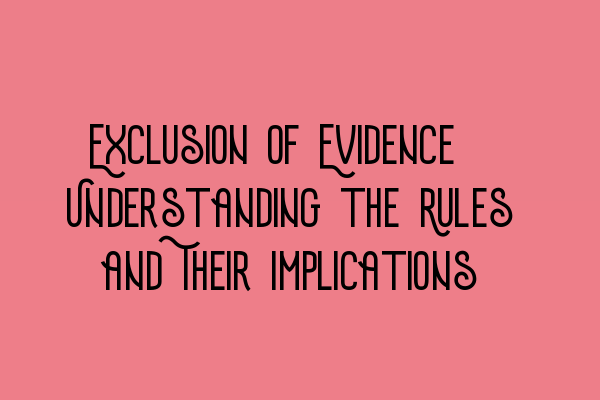Exclusion of Evidence: Understanding the Rules and Their Implications
Welcome to the SQE Criminal Law & Practice Law UK blog! Today, we’ll be diving into a crucial aspect of criminal law – the exclusion of evidence. Understanding the rules surrounding the exclusion of evidence is essential for solicitors and legal professionals in order to effectively represent their clients and navigate the complexities of the criminal justice system.
What is Exclusion of Evidence?
The exclusion of evidence refers to the process through which certain evidence is deemed inadmissible in court proceedings. This can occur for various reasons, such as a violation of a defendant’s rights, the evidence being improperly obtained, or its prejudicial nature.
When evidence is excluded, it means that it cannot be presented or relied upon in court. This can have significant implications for a case, as certain key pieces of evidence may be barred from consideration, potentially affecting the outcome.
Understanding the Rules
The rules governing the exclusion of evidence vary depending on the jurisdiction and the specific circumstances of each case. However, there are some common principles and considerations that solicitors should be familiar with.
Illegally obtained evidence is often excluded from proceedings. This includes evidence obtained without proper authorization or in violation of a defendant’s rights. The exclusionary rule aims to deter unlawful police conduct and preserve the integrity of the criminal justice system.
Additionally, the prejudicial nature of evidence can be grounds for exclusion. If the probative value of the evidence is outweighed by its potential to unfairly prejudice the jury or infringe upon the defendant’s right to a fair trial, it may be excluded.
The chain of custody is another important consideration. If there are gaps or inconsistencies in the documentation of how evidence was handled and stored, it may raise questions about its reliability and could potentially lead to its exclusion.
Hearsay evidence is generally not admissible in court, unless it falls within an exception to the hearsay rule. Hearsay refers to out-of-court statements made by someone other than the witness testifying, and its exclusion ensures that the evidence presented is reliable and subject to cross-examination.
Implications and Case Examples
The exclusion of evidence can have significant implications for a case. It can weaken the prosecution’s case, provide opportunities for the defense, or even result in the dismissal of charges. Understanding the rules and effectively arguing for the exclusion of certain evidence can therefore be crucial for a solicitor’s success in representing their client.
Let’s consider a hypothetical case to illustrate these implications. In a drug trafficking trial, the defendant’s lawyer successfully argued for the exclusion of key evidence due to a violation of the defendant’s Fourth Amendment rights. As a result, the prosecution’s case crumbled, and the defendant was acquitted.
In another example, the exclusion of hearsay evidence in a murder trial weakened the prosecution’s case, leading to the jury finding the defendant not guilty.
These examples highlight the importance of understanding the rules surrounding the exclusion of evidence and utilizing them effectively to advocate for one’s client.
